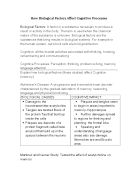Another patient who received damage to their hippocampus and resulted in amnesia is HM. Since he was 9, HM had been having frequent fits and seizures due to his epilepsy, which could not be controlled by drugs. The type of epilepsy that he had is the most common, and is known as psychomotor epilepsy and is localised in the temporal lobes. At age 27 he went through surgery in order to cure his epilepsy, during the surgery the surgeon removed parts of his temporal lobes as well as the hippocampus. The effects of his surgery were that HM suffered from amnesia; most of HM’s memories from before the surgery were intact, which is called partial retrograde amnesia. However he also suffered from anterograde amnesia, as he was unable to store new memories, because he was not able to transfer new semantic memories into the long-term store.
The anterograde amnesia caused by the removal of his hippocampus resulted in HM not being able to remember people he had met or what he has done, as he could not transfer short-term memory into long-term memory. it was clear however that he could still remember some things from before the surgery for example: when the death of his uncle was mentioned it caused him distress and grief.
Roger Sperry conducted a study on participants that have had their corpus callosum severed in order to treat their epilepsy and to prevent their seizures and fits from spreading from one hemisphere of the brain to the other. The corpus callosum is the only part of the brain that connects the two hemispheres; by severing it essentially the patient is left with two individually functioning brains. Sperry conducted research on these patients who are known as ‘split-brain’ patients, in order to determine the functions of each hemisphere. The studies that were performed by Sperry demonstrate that the left and right hemispheres are specialised in different tasks. The results showed that when participants were presented with an image in one half of their visual field and then presented with the same image in the other half of the visual field they responded as if they had never seen the image before. If the same image was presented in the original visual field the participants were able to recognise the image as one they had seen before.
Participants were not able to give a description of an image that was shown to the left hand side of the visual field. The image was either not noticed or just appeared as a flash. Although they could respond non-verbally by pointing with their left hand to a matching picture or selecting an object presented among a collection of other pictures and objects. This of course only works with right-handed participants.
If two symbols were presented simultaneously, one on either side of the visual field (e.g. a dollar sign on the left and a question mark on the right) and the participant was required to draw with their left-hand (shielded from their own view) what they had seen, they would draw the left visual field symbol (a dollar sign). If they were required to say what they had just drawn, the participant would say by name, the right visual field symbol (a question mark).
Objects put in the participants hand for identification by touch could be described or named in speech or writing if they were in the right hand but if placed in the left hand, the participant could either only make wild guesses or even appeared to be unaware that anything at all was present. However, if the object was taken from the left hand and placed in a ‘grab bag’, or was scrambled among other test items, the participant was able to search out and retrieve it with their left hand.
The experiment showed that the individual hemispheres have separate visual perception, memory storage, and also different capacities, e.g. visual stimuli perceived by the left hemisphere could be verbally repeated and written down, but stimuli perceived only by the right hemisphere could only be identified by pointing at it.
After looking at the case studies of Clive Wearing, HM and the studies performed by Sperry it can be concluded that the cognitive process: memory is affected by damage to areas in the brain such as the hippocampus as well as if the two hemispheres are deconnected by severing the corpus callosum. Therefore there are many ways in which biological factors may influence a cognitive process.








